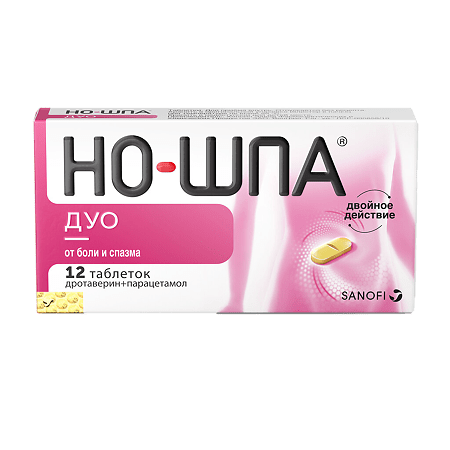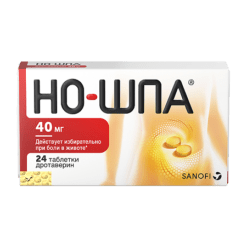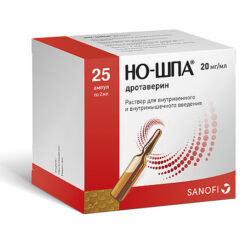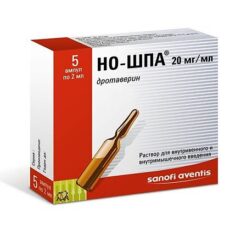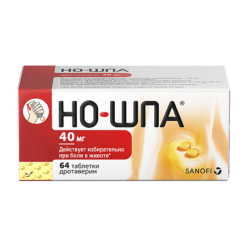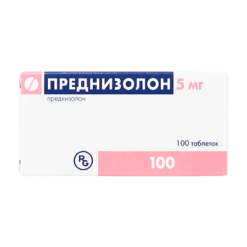No products in the cart.
No-Spa Duo, 40 mg+500 mg tablets 12 pcs
€6.58 €5.48
Out of stock
(E-mail when Stock is available)
Description Pharmacotherapeutic group: Analgesic combined (analgesic non-narcotic agent + antispasmodic agent) Pharmacodynamics: Pharmacokinetics:
ATC: N.02.B.E.51 Paracetamol in combination with other drugs, excluding psycholeptics
A combination drug whose action is due to its constituent components.
Drotaverine is an isoquinoline derivative with antispasmodic effects on smooth muscle (inhibition of the enzyme phosphodiesterase IV, increased concentration of cAMP, which, by inactivating the enzyme myosin kinase, leads to relaxation of smooth muscle). Drotaverine also has a weak inhibitory effect on calmodulin-dependent calcium channels.
Regardless of the type of autonomic innervation, drotaverine is effective in smooth muscle spasms. It acts on smooth muscles in the vascular, gastrointestinal, biliary and urogenital systems (the content of phosphodiesterase IV in different tissues is different).
Paracetamol has analgesic and antipyretic effect mainly by inhibiting the synthesis of prostaglandins in the central nervous system. In inflamed tissues, cellular peroxidases neutralize the effect of paracetamol, which explains the almost complete absence of anti-inflammatory effect. The absence of blocking effect on the synthesis of Pg in peripheral tissues determines the absence of negative effects of paracetamol on water-salt metabolism (sodium and water retention) and the mucous membrane of the gastrointestinal tract.
Paracetamol is rapidly absorbed in the gastrointestinal tract and distributed to most organs and tissues. Absorption is high, time to reach maximum concentration is reached in 0.5-2 h; maximum concentration is 5-20 mcg/ml. Binding with plasma proteins is 15%. Penetrates through the blood-brain barrier. Less than 1% of the dose taken by a nursing mother passes into breast milk.
It is metabolized in the liver (90-95%): 80% enters into conjugation reactions with glucuronic acid and sulfates to form inactive metabolites; 17% undergoes hydroxylation to form 8 active metabolites, which conjugate with glutathione to form already inactive metabolites. In case of glutathione deficiency these metabolites can block enzyme systems of hepatocytes and cause their necrosis. The CYP2E1 isoenzyme is also involved in metabolism of the drug.
The elimination half-life is 1-4 hours. It is excreted by the kidneys as metabolites, mainly conjugates, only 3% is unchanged.
In elderly patients the drug clearance decreases and the elimination half-life increases.
Drotaverine when administered orally is rapidly and almost completely absorbed, absorption is high, the half-absorption period is 12 minutes. Bioavailability is 100%. It is evenly distributed in the tissues, penetrates into the smooth muscle cells.
Time to reach maximum concentration – 2 hours.
The binding to plasma proteins is 95-98%.
The elimination half-life is 1-4 hours. It is mainly excreted by kidneys, to a lesser extent – with bile.
It does not pass through the blood-brain barrier.
.
Indications
Indications
Active ingredient
Active ingredient
Composition
Composition
How to take, the dosage
How to take, the dosage
Overly, with plenty of fluid 1-2 hours after a meal (taking the drug immediately after a meal leads to delayed onset of action).
In children aged 6 to 12 years the drug is prescribed in a single dose of 1/2 tablet, reapplication of the drug is possible after 10-12 hours, the maximum dose is 2 tablets per day.
Adults and adolescents over 12 years of age are recommended to take the drug in a single dose of 1 -2 pills, and if necessary the drug can be repeated after 8 hours. If the course of treatment is short (not more than 3 days), the maximum daily dose is 6 tablets; if the course of treatment is longer, it should not exceed 4 tablets a day.
In elderly patients with normal hepatic and renal function no adjustment of the dose of the drug is required; in patients with hepatic and/or renal insufficiency the dose of the drug should be reduced and set individually.
The maximum duration of treatment without medical consultation is 3 days.
Interaction
Interaction
Drotaverine reduces the effect of levodopa (tremor and rigidity may increase).
The co-administration of paracetamol with chloramphenicol increases the elimination half-life of chloramphenicol and increases its toxicity.
The concomitant use of paracetamol with doxyrubicin increases the risk of liver function abnormalities.
Special Instructions
Special Instructions
The risk of liver damage increases in patients with alcoholic hepatosis.
In mild to moderate renal and hepatic insufficiency, the dose should be adjusted individually.
When using the drug for more than 3 days and/or high doses it is necessary to monitor the picture of peripheral blood (number of leukocytes, platelets) and functional state of the liver (activity of “liver” enzymes). Clinical and laboratory symptoms of hepatotoxic effect begin to appear within 48-72 hours after taking high doses of the drug.
Contraindications
Contraindications
Side effects
Side effects
Central nervous system disorders (usually developed with high doses): dizziness, headache, somnolence.
Cardiovascular system: arterial hypotension, arrhythmia, tachycardia, “hot flashes”.
Digestive system disorders: nausea, constipation, rarely (in high doses) – toxic liver damage.
Hematopoietic system disorders: with prolonged use in high doses – aplastic anemia, agranulocytosis, thrombocytopenia.
Allergic reactions: skin rash, very rarely – bronchospasm, nasal mucous membrane edema.
Overdose
Overdose
Symptoms due to paracetamol overdose: during the first 24 hours after ingestion – pale skin, nausea, vomiting, anorexia, abdominal pain; impaired glucose metabolism, metabolic acidosis.
The symptoms of hepatic dysfunction may appear 12-48 hours after overdose. In severe overdose – hepatic failure with progressive encephalopathy, coma; acute renal failure with tubular necrosis (including in the absence of severe liver damage); arrhythmia, pancreatitis. Hepatotoxic effect in adults occurs when taking 10 g or more.
Treatment: gastric lavage, saline laxatives, administration of donators of SH-groups and precursors of glutathione-methionine synthesis in 8-9 hours after overdose and N-acetylcysteine – in 12 hours. The need for additional therapeutic measures (further administration of methionine, intravenous N-acetylcysteine) is determined depending on the concentration of paracetamol in blood, as well as on the time elapsed after its administration. In severe damage to the central nervous system, artificial lung ventilation and oxygen therapy may be necessary.
Pregnancy use
Pregnancy use
Additional information
| Shelf life | 2 years. Do not use after the expiration date printed on the package. |
|---|---|
| Conditions of storage | Store in the original package (blister in the pack), at a temperature not exceeding 25 ° C. Store out of reach of children. |
| Manufacturer | Hinoin Pharmaceutical and Chemical Works, Hungary |
| Medication form | pills |
| Brand | Hinoin Pharmaceutical and Chemical Works |
Other forms…
Related products
Buy No-Spa Duo, 40 mg+500 mg tablets 12 pcs with delivery to USA, UK, Europe and over 120 other countries.

